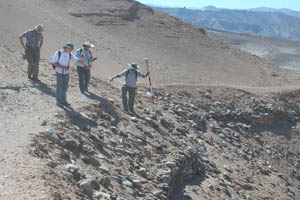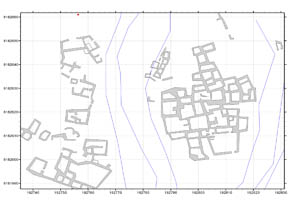| In the Vitor Valley, in the southwest of Peru, the remains of several ancient settlements are now identified as the Millo complex. This complex includes a large wall enclosing a mountain top between the different settlements: |
|
Archaeological
analysis of the Millo complex has so far revealed
residential and administrative or ceremonial areas,
all of which are currently being studied by controlled
excavations, finds analysis and architectural
investigations:
|
|
|
|
|
 |
|
 |
|
|
|
|
|
|
To participate in
the Misti Archaeological Project in the Vitor Valley,
near Arequipa in southern Peru, especially to continue
the topographical survey of the different Millo sites
and instruct students in the use of various survey
instruments (total station, differential GPS) and
software (ForeSight, AutoCAD, ArcGIS). Analysis of the
recovered ceramics and the
organic residues preserved therein is on-going. |
|
|
|
- July 2010 - July 2011 - July 2012 - July 2013 - July 2014 - July 2015 |
|
|
|
Students, staff and faculty of the Misti Archaeological Project, directed in the field by Augusto Cardona, Centro de Investigaciones Arqueologicas de Arequipa, and Maria Cecilia Lozada, University of Chicago. | |
| Results: | |
All structures at
Millo II, III and IV, the major sites within the Millo
complex, were located on a measured plan, while the
location of other ancient sites were determined.
Selected areas of Millo II were excavated revealing the
remains of household and communal activities below a
thick layer of tephra
(volcanic ash) laid down around 1600 CE. Part of our research was published in, among others: Nigra, B.T., A. Cardona Rosas, M.C. Lozada and H. Barnard, “Reconstructing the built environment of the Millo Complex, Vitor Valley, Peru,” Ñawpa Pacha, Journal of Andean Archaeology 37, 2017: pp. 39-62. DOI: 10.1080/00776297.2017.1324011. |
| Approximate position and date of the site: | The different Millo sites are located near the northern end of Valle de Vitor, about 40 km. southwest of Arequipa, the second largest city in Peru. The Millo complex comprises a number of sites mostly dating from 500 BCE-1550 CE (contemporary with the Tiwanaku, Wari and Inka cultures). | |
| Short description of the site: | The Vitor Valley is
a fertile Andean Valley in the shadow of the Chachani
and Misti volcanoes. Since the colonial invasion of Peru
most of the agriculture concentrates on grapes, for wine
and pisco production, now supplemented with horticulture
(artichokes, peppers, onions) and subsistance farming. The main focus of our research in the Vitor
Valley is currently Millo II, the largest ancient site
in the area. This site apparently reflects a combination
of local and Wari influences, now interpreted as the
Wari Empire at least temporarily dominating the local
cultural and administrative structures, but not
completely replacing them. Millo II comprises
residential areas, but also an section currently
interpreted as administrative or ceremonial and a
mountaintop enclosed by a wall but otherwise mostly void
of structures. Other sites within the Millo complex are
further from the river and the fields in the valley.
They are either contemporaneous with Millo II or predate
that site. Their function and relation to Millo II and
Valle de Vitor is as yet unclear. |
|
| Additional remarks: | My work in Peru
would not have been possible without the Vitor Archaeological Project, the Cotsen
Institute of Archaeology and the Institute for Field
Research. |
|
|
|
||
| HOME |